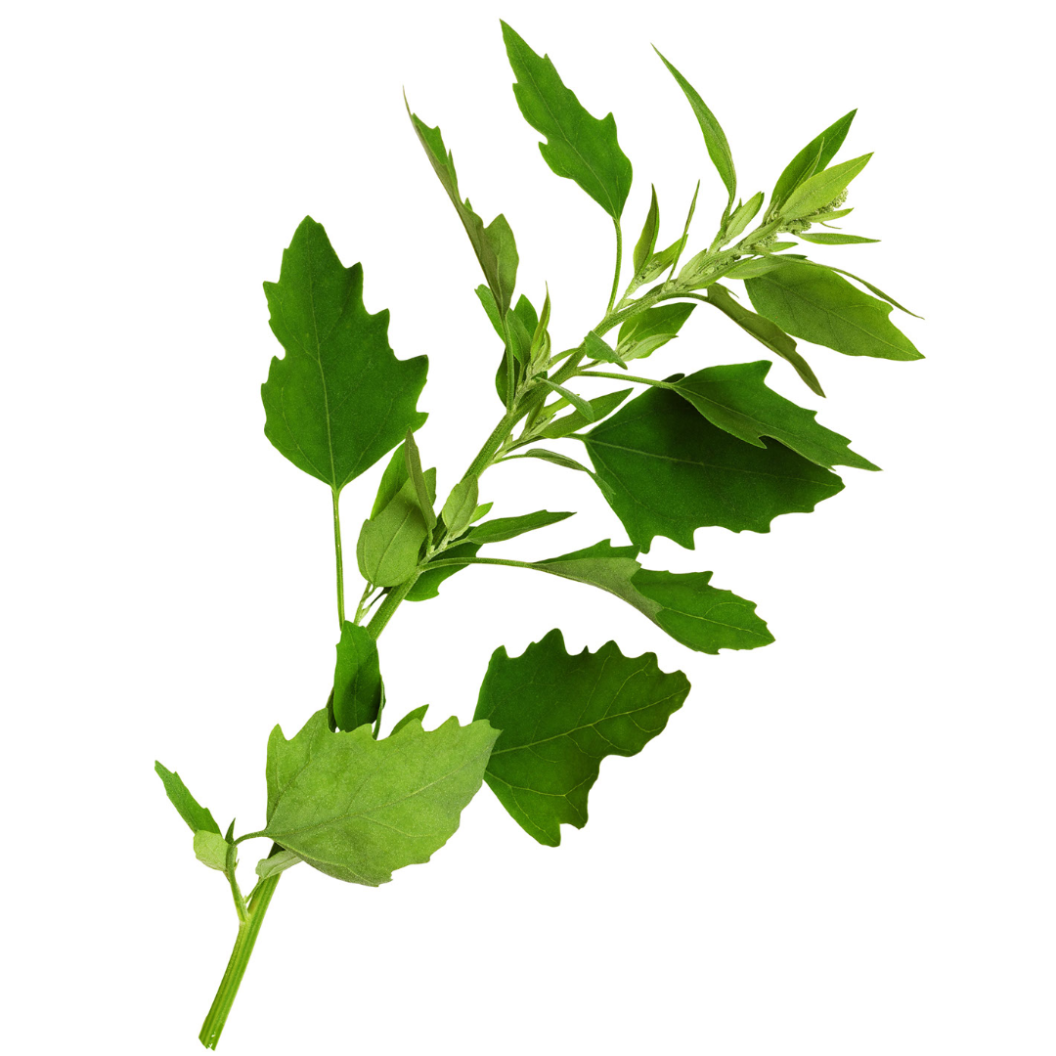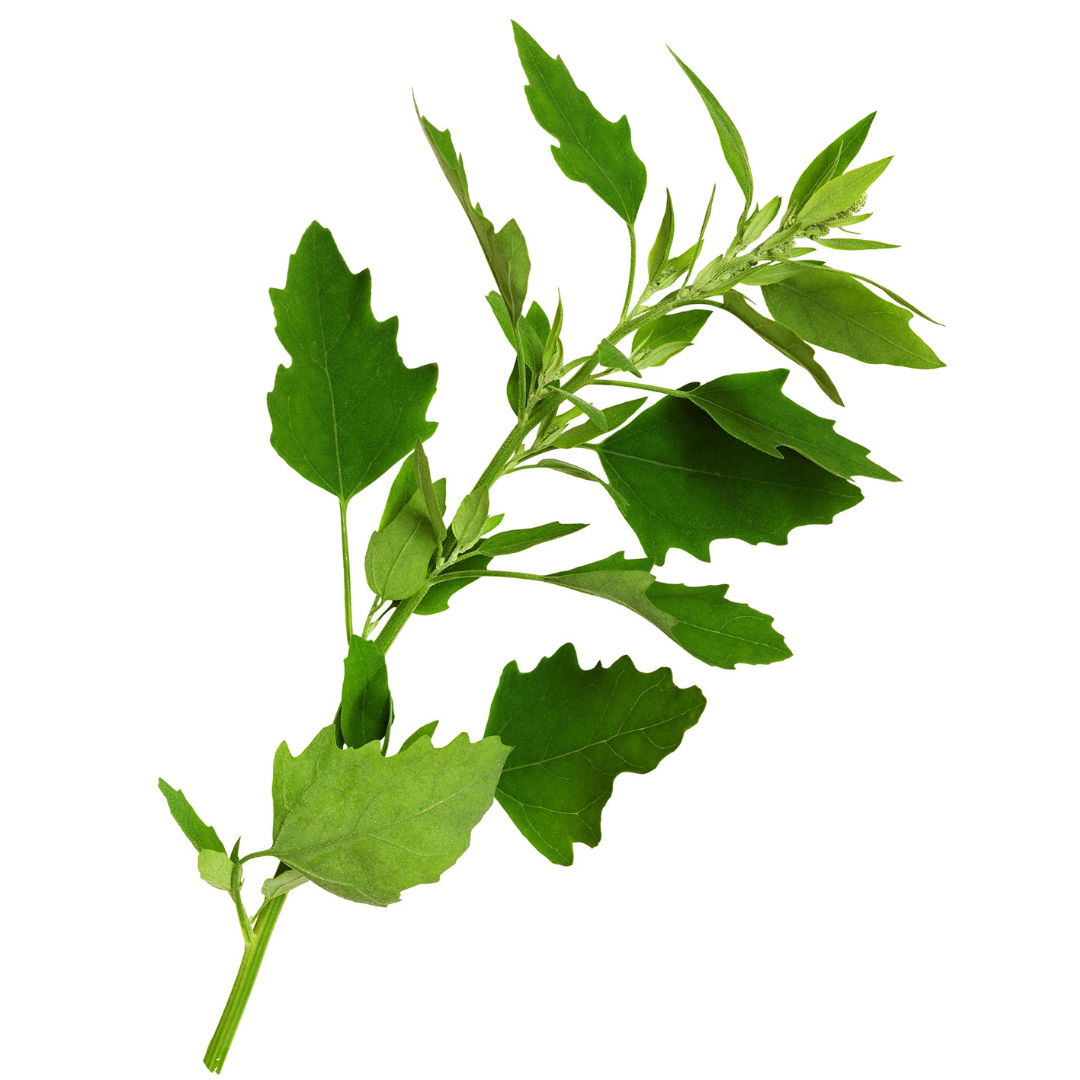
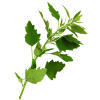
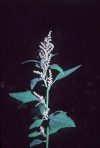
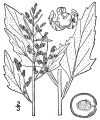
Lambsquarters
DESCRIPTION: Lambsquarters is a fast-growing annual that can grow up to 6 feet tall, with green leaves that are shaped like a goose's foot. The leaves are often coated with a powdery substance that easily rubs off, and the stems are slightly fuzzy. It is a very hardy plant that can be found growing in many different environments
SCIENTIFIC NAME: Chenopodium album
OTHER NAMES: Goosefoot, Pigweed, Fat-Hen, White Goosefoot, Wild Spinach
LEAF TYPE: Broadleaf
FLOWERS: The flowers are very small and green in color. They are arranged in clusters along the stems and branches of the plant. The clusters are not very dense and look a bit like miniature versions of the plant itself. As the flowers mature, they turn into little black seeds.
LEAVES: The lambsquarters' leaves are quite distinctive and easy to recognize. They are bright green in color and shaped like a goose's foot, hence one of the plant's common names. The leaves are medium-sized, with a slightly serrated edge and a smooth surface. They have a slightly wavy appearance and can be slightly fuzzy to the touch. One interesting characteristic of the leaves is that they are often coated with a powdery substance that easily rubs off. This substance, a defense mechanism, protects the plant from pests and disease. Despite their slightly rough texture, the leaves are edible and can be used in cooking or eaten raw in salads. They have a mild flavor similar to spinach or other leafy greens.
LIFE CYCLE: Annual
HOW TO IDENTIFY: Lambsquarters can be identified using a few of its key characteristics. First, look for it to be pretty tall. The stems and leaves will be a bright green color and the leaves will be shaped like a goose's foot. The leaves will likely be coatd with a white, powdery substance that rubs off easily. The flowers will be small and green in color, arranged in clusters along the stems and branches.
MECHANICAL CONTROL RECOMMENDATIONS:
1. Hand pulling - More Info
2. Hoeing - More Info
3. Mulching - More Info
4. Mowing - More Info
5. Tilling - More Info
6. Flame Weeding - More Info
7. Cover Crops - More Info
8. Cultivation - More Info
9. Smothering - More Info
10. Herbicide-Free Areas - More Info
It's essential to remember that mechanical control alone may not entirely eliminate Poa annua, especially in areas where the grass is actively managed, like golf courses and sports fields. Combining mechanical methods with chemical control and cultural practices can offer more effective long-term management. Always follow best practices and local regulations when using herbicides or pesticides. For large-scale control efforts, it's a good idea to consult with a professional turfgrass manager or horticulturist.
CHEMISTRY RECOMMENDATIONS:
"Pre-emergent herbicides:
Oryzalin: Oryzalin is a pre-emergent herbicide that forms a barrier in the soil to prevent the growth of weed seeds, including Chenopodium album.
Pendimethalin: Pendimethalin is a widely used pre-emergent herbicide that creates a barrier on the soil surface, preventing weed seedlings from emerging.
Prodiamine: Prodiamine forms a barrier in the soil that inhibits weed seed germination. It's effective for controlling Chenopodium album and other weed species.
Dithiopyr: Dithiopyr is a pre-emergent herbicide that prevents cell division in germinating seeds. It can provide control over Chenopodium album.
Isoxaben: Isoxaben is a pre-emergent herbicide that inhibits cell wall synthesis in emerging plants. It can be effective for controlling Chenopodium album.
Benefin + Oryzalin: This is a combination of two pre-emergent herbicides that provide extended control over a range of weed species, including Chenopodium album.
Trifluralin: Trifluralin is a pre-emergent herbicide that disrupts root development in germinating seeds. It can be effective for controlling lambsquarters.
Treflan: Treflan is another pre-emergent herbicide that contains trifluralin as the active ingredient. It's commonly used to prevent weed germination.
Post-emergent herbicides:
Glyphosate: Glyphosate is a non-selective herbicide that can be used to control Chenopodium album. It's systemic and kills the entire plant, so use it with caution to avoid harming desirable plants.
Dicamba: Dicamba is a selective herbicide that targets broadleaf plants, including Chenopodium album. It's often used in combination with other herbicides for better effectiveness.
Triclopyr: Triclopyr is a systemic herbicide effective against many broadleaf weeds, including Chenopodium album. It's often used for spot treatments.
2,4-D: 2,4-D is a selective herbicide targeting broadleaf plants. While it can be effective against Chenopodium album, it might not provide complete control and is best used as part of an integrated approach.
Metsulfuron-methyl: This is a systemic herbicide that can be effective against certain broadleaf weeds, including Chenopodium album. It's commonly used in turfgrass and non-crop settings.
Fluroxypyr: Fluroxypyr is a broadleaf-selective herbicide that can be used to control Chenopodium album and similar weeds.
Clopyralid: Clopyralid targets broadleaf plants and can be effective against Chenopodium album. It's often used in lawns and non-crop areas.
Aminopyralid: Aminopyralid is another selective herbicide that targets broadleaf plants. It can provide control over Chenopodium album when used according to the label instructions.
Carfentrazone: Carfentrazone is a contact herbicide effective against a range of broadleaf weeds, including Chenopodium album. It causes rapid desiccation of plant tissues.
Mesotrione: Mesotrione is a herbicide that affects chlorophyll production in plants, leading to their decline. It can be used to control Chenopodium album in certain situations.
Selective herbicides:
Triclopyr: Triclopyr is a systemic herbicide that primarily targets broadleaf plants. It can be used to control Chenopodium album while minimizing damage to grasses and other non-target plants.
Metsulfuron-methyl: Metsulfuron-methyl is a systemic herbicide effective against a range of broadleaf weeds, including Chenopodium album. It's commonly used in turfgrass and non-crop settings.
Clopyralid: Clopyralid is a selective herbicide that targets broadleaf plants. It can be used to control Chenopodium album while sparing grasses and other desirable vegetation.
Aminopyralid: Aminopyralid is a broadleaf-selective herbicide effective against various invasive plants, including Chenopodium album. It's often used as part of a mixture with other herbicides.
Fluroxypyr: Fluroxypyr is a selective herbicide used to control broadleaf weeds. It can provide effective control of Chenopodium album while minimizing harm to grasses.
Carfentrazone: Carfentrazone is a contact herbicide that targets a wide range of broadleaf weeds, including Chenopodium album. It causes rapid desiccation of plant tissues.
Mesotrione: Mesotrione is a herbicide that affects chlorophyll production in plants. It can be used selectively to control Chenopodium album and other broadleaf weeds.
Dicamba (with caution): Dicamba is a selective herbicide that targets broadleaf plants. While it can control Chenopodium album, it should be used with caution to prevent damage to non-target plants.
2,4-D (with caution): 2,4-D is a broadleaf-selective herbicide that can provide partial control of Chenopodium album. Use it carefully to avoid harming non-target plants.
Non-Selective herbicides:
Glyphosate: Glyphosate is one of the most commonly used non-selective herbicides. It's systemic and kills the entire plant by inhibiting a vital enzyme for plant growth. Use it with caution to avoid damaging desirable plants.
Glufosinate: Glufosinate is a non-selective herbicide that disrupts plant processes and causes rapid tissue damage. It's effective for controlling Chenopodium album but can also impact surrounding vegetation.
Paraquat: Paraquat is a fast-acting non-selective herbicide that causes rapid desiccation of plant tissues upon contact. It's highly toxic and should be used with extreme caution.
Diquat: Diquat is another contact herbicide that works by desiccating plant tissues. It's effective for controlling Chenopodium album and can provide quick results.
Pelargonic Acid: Pelargonic acid is a fatty acid-based herbicide that burns and desiccates plant tissues on contact. It's effective for controlling weeds but might require multiple applications.
Triclopyr (with caution): While triclopyr is primarily considered a selective herbicide, certain formulations can be used in higher concentrations or with repeat applications to achieve non-selective control. Be careful to avoid damaging non-target plants.
Imazapyr (with caution): Imazapyr is a systemic herbicide effective against a wide range of plants, including woody species. It can be used for non-selective control but should be used carefully to avoid harming desirable plants.
Flaming (using propane torch): Flame weeding involves using a propane torch to briefly apply heat to weed foliage, causing tissue damage. It's effective for controlling weeds like Chenopodium album, especially in smaller areas.
Recommended Prevention
Recommended Control

